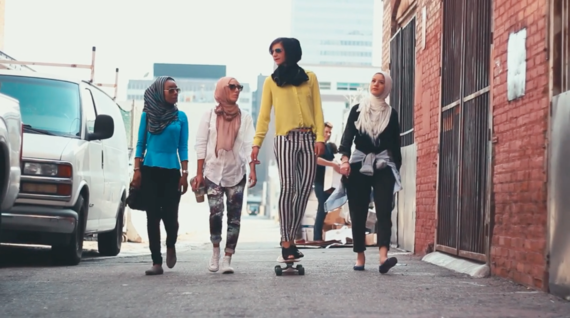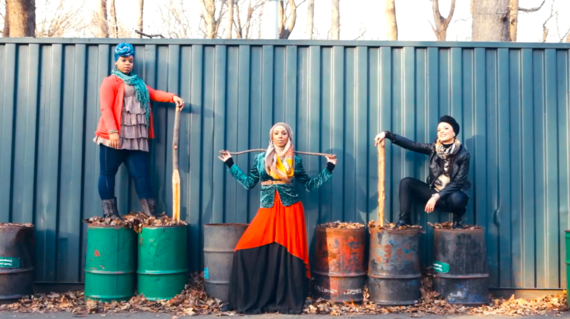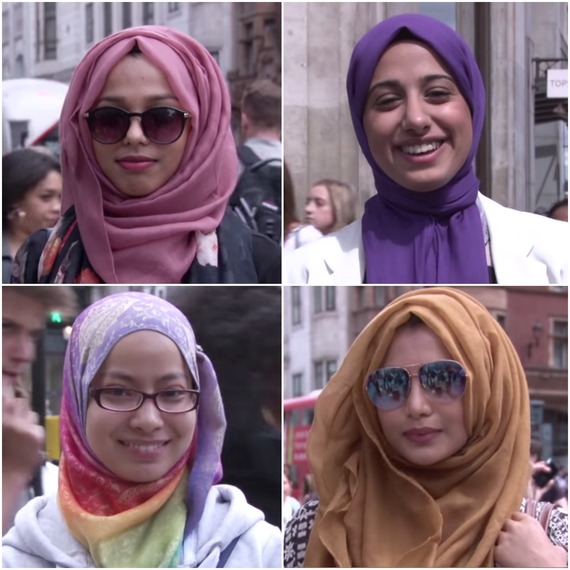Fed up with being depicted as out-dated and oppressed, a group of young American Muslim women created a video. In which they painted a picture of a colourful, vibrant Islam. A picture of their reality.
![2015-12-10-1449767040-1422419-ScreenShot20151210at17.00.14.png]()
![2015-12-10-1449767074-875603-ScreenShot20151210at17.00.00.png]()
![2015-12-10-1449767098-5310053-Bildschirmfoto20131205um22.44.15.png]()
"Somewhere in America #Mipsterz" Sheikh & Bake Productions
A year on from the #Mipsterz video and the term (a hybrid of the words 'Muslim' and 'Hipster') is firmly implanted in the popular public conscience. But who are the individuals that make up this new subculture? And what impact has its popularity had on young Muslim women's place in Western society?
I sat down with Reina Lewis, professor of cultural studies at London College of Fashion, to discuss these topics, which form the basis of her new book 'Muslim Fashion: Contemporary Style Cultures.'
So, let's start at the beginning. What's the book about?
The book looks at the exciting style phenomenon of young women who are combining the requirements of their religion with their participation in mainstream fashion cultures.
All around us on the streets of London, and elsewhere in Britain, we are seeing lots of cool, young hijabis.
Yet, these young women are rarely celebrated as part of British street fashion. I think that the way they're dressing, the clothes they're making and the clothes they're writing about in their blogs and magazines deserve serious attention.
Why have you chosen to write this book now?
What we are seeing at the moment is a reactivation of much older historical stereotypes about Muslim women. There is a mystery surrounding the veil, an idea that veiled women from Muslim cultures are somehow different; exotic but also potentially threatening. Given this discourse, I think that it is so important to talk about the lived reality of Muslims in British society. To challenge those stereotypes that position Muslims as somehow separate to modernity.
Fashion, is something that people use to communicate who they are and Muslim women are no exception. They are individuals and not a representative of an unchanging, a-historical, collective group identity. Like everyone, they are positioned in relation to fashion and they're using fashion to communicate how they feel about their place in the world. Now I wouldn't for a minute suggest that fashion is going to end world problems, or that consumer culture will bring about world peace but I do think it's important to de-exceptionalise Muslims and to overcome these perceived differences.
![2015-12-10-1449760418-993756-HijabFashionCollage.jpg]()
Images captured on London's Oxford Street
Who have you found are the main participants in this movement?
This is primarily a youthful phenomenon. When I say young, I mean women under 40. I've been researching this for over 10 years now so this pioneering cohort, who were between 18 and 28 years old when I first started are now between 28 and 38 years of age.
They're accustomed to global consumer culture and they expect to express and communicate this part of themselves just like anybody else in their age group.
The presence of hijab-wearing fashion bloggers has seen a sharp rise in the last few years. What do you think is the importance of the Internet as a space for conversation?
The Internet has been absolutely essential to the development of modest fashion. In terms of commerce, there are much lower risks; you don't need to have premises and you don't need to keep that much inventory or masses of stock. Also when you sell online, people from all over the world can buy your stuff. This has allowed creative entrepreneurs and designers in modest fashion to start companies. Very often, these companies emerge because these women can't find what they want in the shops, so they might want a maxi skirt but one that doesn't have a slit to the thigh or doesn't come in a transparent floral fabric.
The Internet is also a space for commentary and there is an extremely active bloggersphere for hijab fashion, particularly in the UK. What is emerging is what some people are calling a 'modest fashion movement,' where women from different faith backgrounds are supporting each other in their quest to find stylish modesty. The Internet has created a platform for people to air their opinions. Anyone can start a blog or a YouTube channel and those who don't can join in the discussions started by those who do. Whilst there have been print magazines that have aimed to do the same, they are a lot harder to sustain, especially because a lot of the mainstream brands don't want to advertise in a modest or Muslim fashion magazine.
This said, it is really important to acknowledge that this modern fashion movement is not without conflict or dispute. New technologies such as smartphones mean that it is much easier to post comments.
Many of the women involved are highly committed to accepting different interpretations and opinions but often they'll be met with a lot of criticism. These negative comments quite often come from men, who these women do not see as their target audience but who are the self appointed guardians of female modesty online. This can be very difficult to take.
This interview is an extract from an interview I conducted with professor Reina Lewis. Some more of the interview is included in my TV feature on Hijab Fashion for news show London360. If you would like to buy her book it is available now.



A year on from the #Mipsterz video and the term (a hybrid of the words 'Muslim' and 'Hipster') is firmly implanted in the popular public conscience. But who are the individuals that make up this new subculture? And what impact has its popularity had on young Muslim women's place in Western society?
I sat down with Reina Lewis, professor of cultural studies at London College of Fashion, to discuss these topics, which form the basis of her new book 'Muslim Fashion: Contemporary Style Cultures.'
So, let's start at the beginning. What's the book about?
The book looks at the exciting style phenomenon of young women who are combining the requirements of their religion with their participation in mainstream fashion cultures.
All around us on the streets of London, and elsewhere in Britain, we are seeing lots of cool, young hijabis.
These women are taking the sign of the hijab, of clothes that makes them visible as Muslims, and de-stigmatising them. They are using fashion as a form of communication.
Yet, these young women are rarely celebrated as part of British street fashion. I think that the way they're dressing, the clothes they're making and the clothes they're writing about in their blogs and magazines deserve serious attention.
Why have you chosen to write this book now?
What we are seeing at the moment is a reactivation of much older historical stereotypes about Muslim women. There is a mystery surrounding the veil, an idea that veiled women from Muslim cultures are somehow different; exotic but also potentially threatening. Given this discourse, I think that it is so important to talk about the lived reality of Muslims in British society. To challenge those stereotypes that position Muslims as somehow separate to modernity.
Britain is a multi-cultural society, with a variety of people in it and actually the more that we can talk about the ways in which all of us as citizens of this country intersect with the different cultures around us, the better.
Fashion, is something that people use to communicate who they are and Muslim women are no exception. They are individuals and not a representative of an unchanging, a-historical, collective group identity. Like everyone, they are positioned in relation to fashion and they're using fashion to communicate how they feel about their place in the world. Now I wouldn't for a minute suggest that fashion is going to end world problems, or that consumer culture will bring about world peace but I do think it's important to de-exceptionalise Muslims and to overcome these perceived differences.

Who have you found are the main participants in this movement?
This is primarily a youthful phenomenon. When I say young, I mean women under 40. I've been researching this for over 10 years now so this pioneering cohort, who were between 18 and 28 years old when I first started are now between 28 and 38 years of age.
Many of these young women are 2nd or 3rd generation from migrant families. They've grown up immersed in British culture, literate in British languages and also literate in fashion.
They're accustomed to global consumer culture and they expect to express and communicate this part of themselves just like anybody else in their age group.
The presence of hijab-wearing fashion bloggers has seen a sharp rise in the last few years. What do you think is the importance of the Internet as a space for conversation?
The Internet has been absolutely essential to the development of modest fashion. In terms of commerce, there are much lower risks; you don't need to have premises and you don't need to keep that much inventory or masses of stock. Also when you sell online, people from all over the world can buy your stuff. This has allowed creative entrepreneurs and designers in modest fashion to start companies. Very often, these companies emerge because these women can't find what they want in the shops, so they might want a maxi skirt but one that doesn't have a slit to the thigh or doesn't come in a transparent floral fabric.
The Internet is also a space for commentary and there is an extremely active bloggersphere for hijab fashion, particularly in the UK. What is emerging is what some people are calling a 'modest fashion movement,' where women from different faith backgrounds are supporting each other in their quest to find stylish modesty. The Internet has created a platform for people to air their opinions. Anyone can start a blog or a YouTube channel and those who don't can join in the discussions started by those who do. Whilst there have been print magazines that have aimed to do the same, they are a lot harder to sustain, especially because a lot of the mainstream brands don't want to advertise in a modest or Muslim fashion magazine.
This said, it is really important to acknowledge that this modern fashion movement is not without conflict or dispute. New technologies such as smartphones mean that it is much easier to post comments.
When you're talking about modest fashion, which brings with it all sorts of moral judgements, about what is real modesty, what is appropriate, what is the correct interpretation, it can be difficult for participants.
Many of the women involved are highly committed to accepting different interpretations and opinions but often they'll be met with a lot of criticism. These negative comments quite often come from men, who these women do not see as their target audience but who are the self appointed guardians of female modesty online. This can be very difficult to take.
This interview is an extract from an interview I conducted with professor Reina Lewis. Some more of the interview is included in my TV feature on Hijab Fashion for news show London360. If you would like to buy her book it is available now.